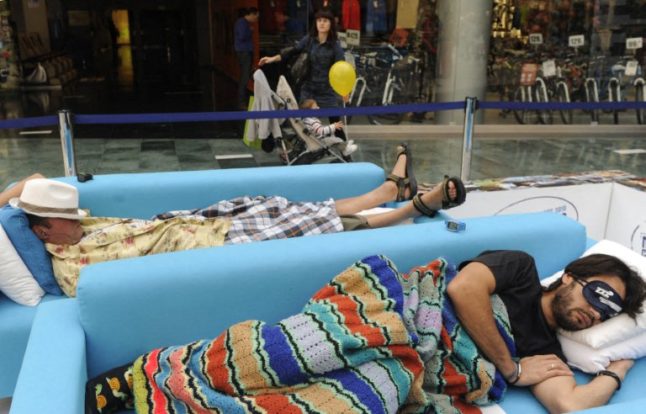Spaniards are an affectionate bunch. They touch you on the shoulder or the arm to reflect friendship, they greet each other with two kisses and they’re very much in favour of hugging friends and family.
But that doesn’t mean that anything goes in Spain, and there is a line to be drawn between what’s culturally acceptable and what’s taking it too far.
This threshold is currently shifting as it’s subject to changing perceptions brought on by an emboldened feminist movement that’s confronting sexual and gender violence which is ingrained in Spain’s patriarchal society.
The country’s new ‘only yes means yes’ sexual consent law, spearheaded by the divisive Minister of Equality Irene Montero, has also meant that knowing the rules is all the more important.
Kissing on the lips
A kiss on the lips is not a standard greeting in Spain, nor is it likely that a platonic smooch with a friend will be well-received.
In a moment of extreme joy, such as an important victory, one may assume that Spaniards’ touchy-feely and laid-back nature would mean that un beso en los labios (a kiss on the lips) could fly, but that’s not how Spanish law views it.
A kiss on the lips is reserved for romantic partners, and if it’s done without the other person’s consent it can now be considered sexual abuse if the other person presses charges, a crime that can result in a damages payment to the victim, a restraining order and technically speaking even a prison sentence.
As the 2022 sexual consent law’s moniker suggests, ‘only yes means yes’ in the sense that you should be getting explicit consent (¿Puedo besarte? – Can I kiss you?) before even the faintest peck.
It doesn’t exactly promote spontaneity but given the fact that consent or the lack thereof is subject to the interpretation of a judge, the best way to avoid any issue is to ask first.
Talk about World cup moments 🙄
The surprising kiss on the mouth of Jennifer Hermoso and Luis Rubiales celebrating the Spanish triumph
Is it now a world Cup kiss ? Was it intentional ? .. 🙂🙃 many questions and one kiss ..I think more subscription for Next WWC now😂 pic.twitter.com/kxFYX82Ltr
— YD Services (@Moresky07) August 20, 2023
Equality Minister Irene Montero has referred to the non consensual kiss that Spanish Football Federation president Luis Rubiales gave player Jenni Hermoso on the lips after Spain’s Women World Cup victory as “sexual violence”. Rubiales first effusively hugged Hermoso, lifted her slightly, then he put his hands on either side of her face and kissed her on the lips before giving her a slap on the back like a team coach.
Talk about World cup moments 🙄
The surprising kiss on the mouth of Jennifer Hermoso and Luis Rubiales celebrating the Spanish triumph
Is it now a world Cup kiss ? Was it intentional ? .. 🙂🙃 many questions and one kiss ..I think more subscription for Next WWC now😂 pic.twitter.com/kxFYX82Ltr
— YD Services (@Moresky07) August 20, 2023
“Acts of sexual violence, especially less intense ones, continue to be invisible and normalised, but it is necessary to call it by its name in order to put an end to it. It is not just machismo, abuse of power or a sexist act: it is sexual violence,” Montero tweeted regarding the controversial incident.
Hermoso did not visibly pull back or react in any way that would suggest she did not consent to Rubiales’ kiss.
She did briefly admit on a live video that she “didn’t like it” but later made a statement stressing that Rubiales and her have a “great relationship” and that it “was a mutual gesture that was completely spontaneous due to the immense happiness of winning the World Cup”, “a gesture of friendship and gratitude”.
Regardless of Spaniards’ opposing views of the incident, Rubiales’ unexpected kiss was clearly inappropriate for the occasion, for his position and for the current zeitgeist, all of which has overshadowed the first World Cup trophy won by Spain’s female national team.
It also serves to evidence the nuances and complexities which come with lunging in to kiss someone on the lips in Spain in 2023, perhaps a necessary conundrum if it serves to stamp out micro sexual aggressions in Spanish society.

Kissing on the cheeks
Kissing on the cheeks isn’t all that common around the world, meaning that foreigners in Spain sometimes get this traditional greeting wrong, which can lead to some awkward situations.
Most of the time, when a man and woman, or a woman and another woman, meet or are introduced to each other in a social setting, they give each other two kisses on the cheeks.
If it’s two men then they tend to shake hands or hug depending on how close they are. Spanish men don’t kiss male friends as much as they do in Italy or France, although it’s more common among fathers and sons.
It’s one kiss on each cheek, starting on the left side (as in your head goes to the left and your right cheek presses against theirs). This can be particularly confusing for kiss-giving nationals like the French who start on the right.
It doesn’t necessarily have to involve lip-cheek contact either, often it’s rather cheek to cheek, lightly brushing against each other.
Don’t worry, you are unlikely to be accused of sexual abuse for giving an acquaintance or friend two kisses as a greeting, nor are they ever likely to pull back (hacer la cobra, ‘do the cobra’ as this is colloquially known) given that greeting someone with two kisses is a tradition in Spain dating back to the Romans.
READ ALSO:



 Please whitelist us to continue reading.
Please whitelist us to continue reading.
Member comments